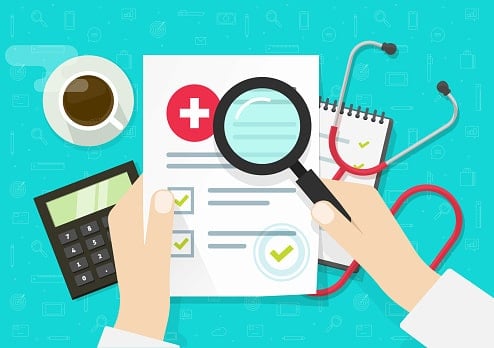- Types of California health insurance
- Best health insurance in California
- Health insurance requirements in California
- Health insurance subsidies in California
- How much is health insurance in California?
- Median monthly Bronze level premium by county
- How to buy health insurance in California
- COBRA insurance in California
- Other ways to get health insurance in California
Types of California health insurance
Californians choose between four health insurance tiers in Covered California. Plans are divided into four metal levels based on premiums and out-of-pocket costs.
Here are the differences between the four plans for an individual:
| Premiums | Out-of-pocket costs | Medical deductible | Pharmacy deductible | Out-of-pocket max | |
|---|---|---|---|---|---|
| Bronze | Lowest premiums | Insurer pays 60% of health care costs | $6,300 | $500 | $9,100 |
| Silver | Higher than Bronze, but lower than other tiers | Four types: 70%, 73%, 87% or 94% of health care costs | $0 to $5,400 | $0 to $150 | $1,150 to $9,100 |
| Gold | Higher than Silver, but lower than Platinum | Insurer pays 80% of health care costs | $0 | $0 | $8,700 |
| Platinum | Highest premiums | Insurer pays 90% of health care costs | $0 | $0 | $4,500 |
Which metal tier is best? It depends on your financial situation and what you want from a health plan.
Who may benefit from a Bronze plan:
- Young, healthy people who don’t expect to need many health care services.
- People who want to pay the lowest premiums possible.
Who may benefit from a Silver plan:
- Households who qualify for additional subsidies that are found in Silver plans.
- People who want low premiums but don’t want huge out-of-pocket costs.
Who may benefit from a Gold plan:
- Californians who expect to need many health care services over the next year.
- Those who don’t mind paying higher premiums while not spending as much when you need health care.
Who may benefit from a Platinum plan:
- Someone who wants to pay the least out-of-pocket costs with the understanding they’ll pay the highest premiums.
- People who expect to use many health care services, visit the doctor often and have multiple prescriptions.
Best health insurance in California
A dozen insurers offer health plans via Covered California:
- Aetna CVS Health
- Anthem
- Balance by CCHP
- Blue California
- Health Net
- IEHP
- Kaiser Permanente
- L.A. Care Health Plan
- Molina Healthcare
- Sharp Health Plan
- Valley Health Plan
- Western Health Advantage
The best health insurance for you depends on what you want from a health plan. Are your doctors in the plan’s network? Would you rather pay higher premiums and less when you need health care? Or would you prefer paying low premiums but higher out-of-pocket costs when you need to see a doctor? Does the plan cover your prescriptions?
Covered California offers three different benefit designs:
- Health maintenance organization (HMO): These plans are usually cheaper than other plans. They’re also more restrictive. You typically must name a primary care provider, you need a referral from that provider to see specialists and the plan won’t pay for out-of-network care unless it’s an emergency.
- Preferred provider organization (PPO): The plans are usually the most expensive, but you have more flexibility. You can get care outside of your network, though you’ll likely pay more, and don’t need to get referrals to see specialists.
- Exclusive provider organization (EPO): The plans are a hybrid of HMOs and PPOs. They require you to stay within your plan’s network, similar to an HMO. However, you don't need to name a primary care provider and don’t need a referral to see a specialist, like a PPO.
Find out more about the differences between health plans.
Also, you may be able to get a plan for dental benefits. These insurers offer dental coverage in Covered California:
- Anthem Blue Cross
- California Dental Network
- Delta Dental of California
- Dental Health Services
- Blue California
Covered California offers two dental plan designs: HMOs and PPOs.
Health insurance requirements in California
Not long ago, nearly all Americans needed to have health insurance. However, Congress has since stopped the individual mandate penalty on the federal level.
California implemented its own individual mandate. Californians must have health insurance or face a fine at tax time.
Here are the penalties:
- At least $900 per adult
- $450 per dependent child under 18
So, a family of four with two parents and two children would be fined $2,700 if they don’t have health insurance.
Health insurance subsidies in California
Americans from all states benefit from cost-saving subsidies in the Affordable Care Act exchanges if their household income qualifies. These subsidies help pay premiums and reduce out-of-pocket costs. As of 2024, the calculation works on a sliding scale.
California previously offered residents an additional health insurance subsidy. However, California stopped its program when the federal government expanded healthcare subsidies through the Inflation Reduction Act.
If your income is 250% of the federal poverty level (FPL), you will only pay up to 4% of your household income toward healthcare premiums. The 250% FPL benchmark in 2024 is $36,450 for an individual and $75,000 for a family of four.
If your FPL is 400% or higher, you pay no more than 8% of your household income on healthcare premiums. In 2024, 400% FPL is $58,320 for an individual or $120,000 for a family of four.
Kaiser Family Foundation offers a tool that estimates health insurance costs for a marketplace plan.
Your household might be eligible for Medicaid through Medi-Cal depending on your income. Medi-Cal offers low-cost or free comprehensive plans.
How much is health insurance in California?
Health insurance costs vary based on premiums, deductibles, out-of-pocket costs, how you receive coverage, and various other metrics.
Kaiser Family Foundation estimates the average monthly costs for the cheapest California health plans are:
- Average lowest-cost Bronze plan: $367
- Average lowest-cost Silver plan: $438
- Average lowest-cost Gold plan: $492
Kaiser Family Foundation didn’t provide estimates for Platinum plans, which make up a tiny portion of Affordable Care Act plans.
Know that these averages don’t take into account subsidies. People eligible for subsidies may pay much less than these averages.
Median monthly Bronze level premium by county
| County | Median |
|---|---|
| Alameda | $404.06 |
| Alpine | $445.73 |
| Amador | $441.51 |
| Butte | $445.73 |
| Calaveras | $445.73 |
| Colusa | $445.73 |
| Contra Costa | $441.69 |
| Del Norte | $445.73 |
| El Dorado | $365.81 |
| Fresno | $280.24 |
| Glenn | $445.73 |
| Humboldt | $445.73 |
| Imperial | $413.34 |
| Inyo | $522.87 |
| Kern | $310.97 |
| Kings | $280.24 |
| Lake | $445.73 |
| Lassen | $445.73 |
| Los Angeles | $278.46 |
| Madera | $280.24 |
| Marin | $422.24 |
| Mariposa | $356.55 |
| Mendocino | $445.73 |
| Merced | $422.91 |
| Modoc | $445.73 |
| Mono | $522.87 |
| Monterey | $578.16 |
| Napa | $422.24 |
| Nevada | $445.73 |
| Orange | $333.21 |
| Placer | $384.39 |
| Plumas | $445.73 |
| Riverside | $296.50 |
| Sacramento | $384.39 |
| San Benito | $578.16 |
| San Bernadino | $296.50 |
| San Diego | $320.10 |
| San Francisco | $414.63 |
| San Joaquin | $356.55 |
| San Luis Obispo | $455.69 |
| San Mateo | $481.36 |
| Santa Barbara | $455.69 |
| Santa Clara | $448.37 |
| Santa Cruz | $573.36 |
| Shasta | $445.73 |
| Sierra | $445.73 |
| Siskiyou | $445.73 |
| Solano | $422.24 |
| Sonoma | $422.24 |
| Stanislaus | $356.55 |
| Sutter | $441.51 |
| Tehama | $445.73 |
| Trinity | $445.73 |
| Tulare | $356.55 |
| Tuolumne | $445.73 |
| Ventura | $391.39 |
| Yolo | $384.39 |
| Yuba | $441.51 |
How to buy health insurance in California
Californians can get a Covered California plan during the annual open enrollment, typically from Nov. 1 to Jan. 31.
However, you can sign up for a Covered California plan during other times if you qualify for a special enrollment period. You may qualify to get a Covered California plan if:
- You lose your job
- You lose your health insurance
- You move
- You turn 26 and are not eligible to stay on parents’ plan
- You get married or enter into a domestic partnership
- You have or adopt a child
- You are a victim of domestic abuse or spousal abandonment
- You are affected by wildfires or other disaster
- You become a U.S. citizen
- Your household size changes
- You return from active military service
- You are released from jail or prison
These events spark a special enrollment period. If you have a qualifying event, you have 60 days to sign up or change your plan.
To enroll, you can go through the Covered California site, apply with a certified enroller or by phone.
To sign up, you’ll need:
- Social security numbers or immigration documents
- Federal tax information if you file
- Employer and income information for your household
Covered California confirms the information on government databases.
COBRA insurance in California
People who recently lost their employer-sponsored health insurance can sign up for a COBRA plan. COBRA allows you to extend your former employer’s plan for a limited time.
However, you have to pay for all the costs. The former employer doesn’t contribute money to help pay premiums.
The federal COBRA law only pertains to employers with 20 or more employees. However, California has a so-called mini-COBRA law that allows Californians who previously worked at a small business to keep COBRA coverage for up to 36 months. If your federal COBRA was for 18 months, Cal-COBRA grants an additional 18 months.
Other ways to get health insurance in California
Besides Covered California, an employer plan, Medicare and Medi-Cal, Californians may also get coverage in other ways:
- An individual plan outside of Covered California
- A catastrophic plan
Individual plans outside Covered California may give you other plan options. However, those plans aren’t eligible for subsidies. So, if you qualify for subsidies, you may want to stay with Covered California.
Meanwhile, eligible Californians can sign up for a catastrophic plan. These plans are only available for people under 30 and those who qualify for a hardship exemption.
Catastrophic plans offer many benefits found in a regular health plan, but with much higher out-of-pocket costs.
If you qualify, you can sign up for a catastrophic plan directly from an insurer. However, Covered California suggests a Bronze plan might make more sense since:
- Bronze and catastrophic plan premiums are similar
- Bronze has lower deductibles
- You are eligible for subsidies with a Bronze plan
One option not available in California is short-term health insurance. These plans, available in most states, have low premiums but high out-of-pocket costs. They also don’t cover health care services found in regular health insurance, such as mental health, prescription drugs and maternity care.
However, California doesn't allow insurers to sell those plans. Instead, you can enroll in Covered California during open enrollment or after a special enrollment life event. Importantly, there is no long-term commitment.
Still not sure about health insurance eligibility? Check out Insurance.com’s Health Plan Finder tool to explore your health insurance eligibility.
Sources
- Covered California. “Covered California Bronze.” Accessed April 2024.
- Covered California. “Covered California Silver.” Accessed April 2024.
- Covered California. “Covered California Gold.” Accessed April 2024.
- Covered California. “Covered California Platinum.” Accessed April 2024.
- Covered California. “Information About Qualified Health and Dental Plan Issuers.” Accessed April 2024.
- Covered California. “Penalty.” Accessed April 2024.
- Covered California. “Health Insurance Through Covered California Is More Affordable Than Ever.” Accessed April 2024.
- KFF. “Explaining Health Care Reform: Questions About Health Insurance Subsidies.” Accessed April 2024.
- KFF. “Average Marketplace Premiums by Metal Tier, 2018-2024.” Accessed April 2024.
- Covered California. “2024 Individual Shared Responsibility Penalty Calculation.” Accessed April 2024.
- Covered California. “Special Enrollment.” Accessed April 2024.
- California Department of Managed Healthcare. “Keep Your Health Coverage (COBRA).” Accessed April 2024.
- Covered California. “Minimum coverage plans.” Accessed April 2024.
- Covered California. “Short Term Health Insurance for Californians.” Accessed April 2024.




